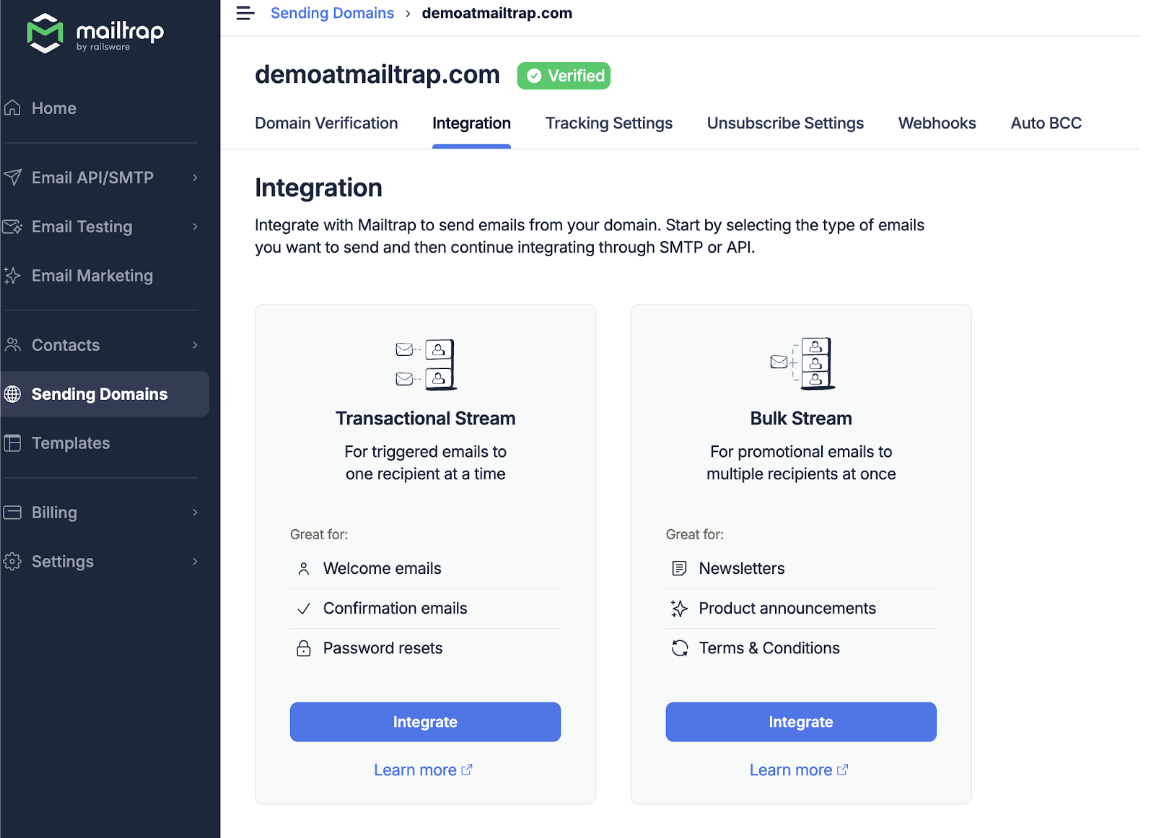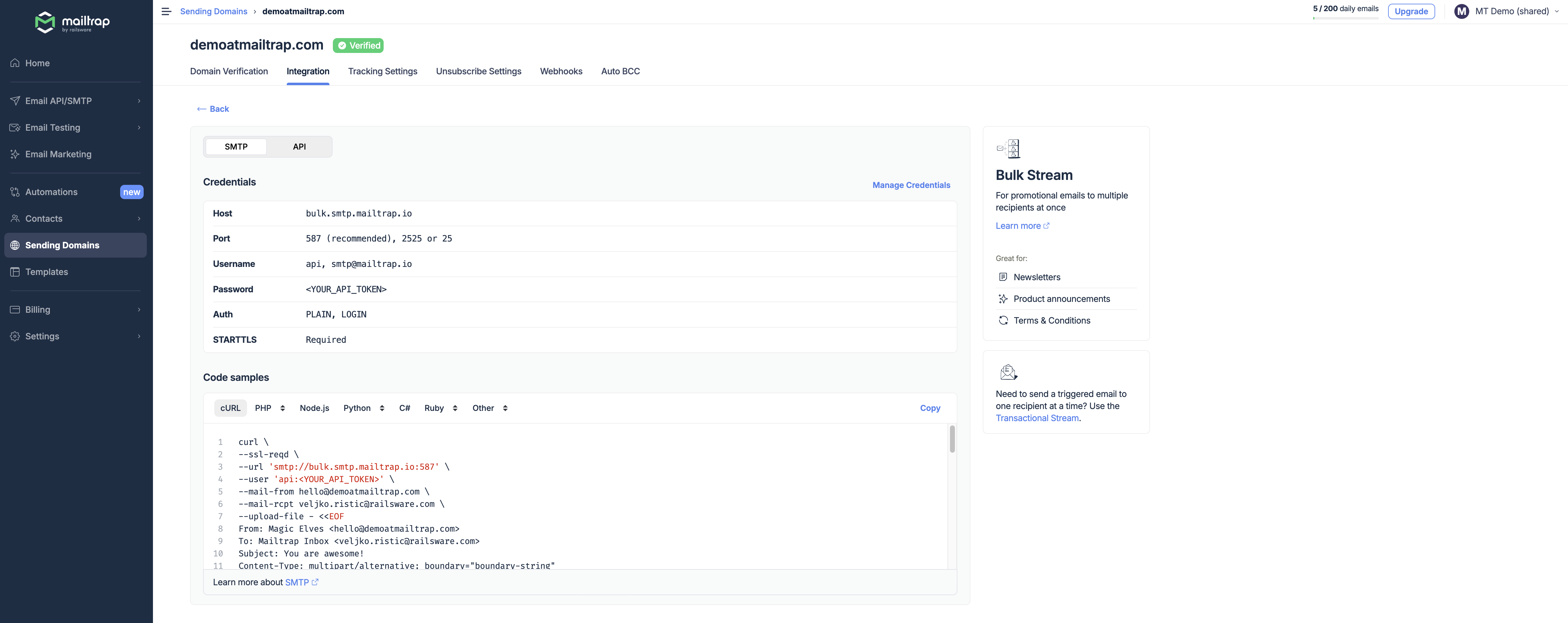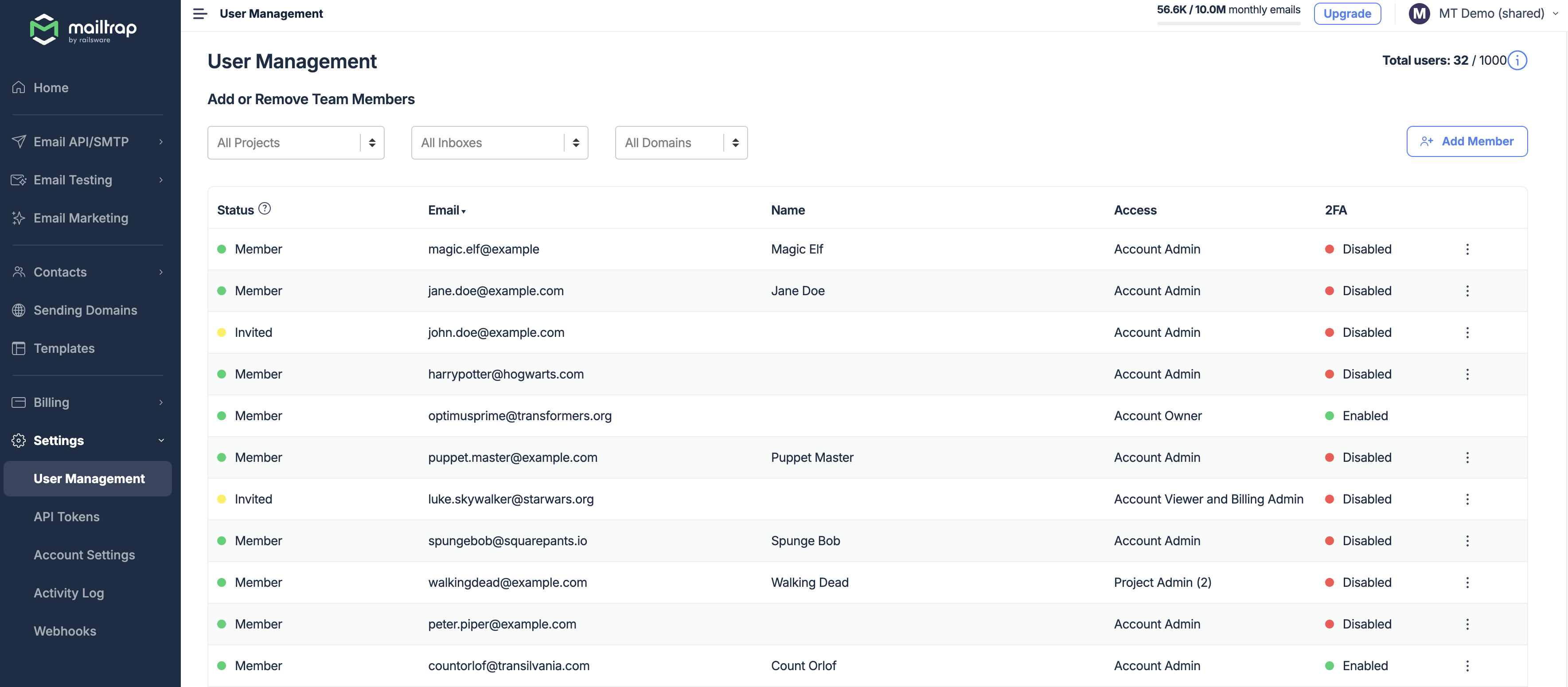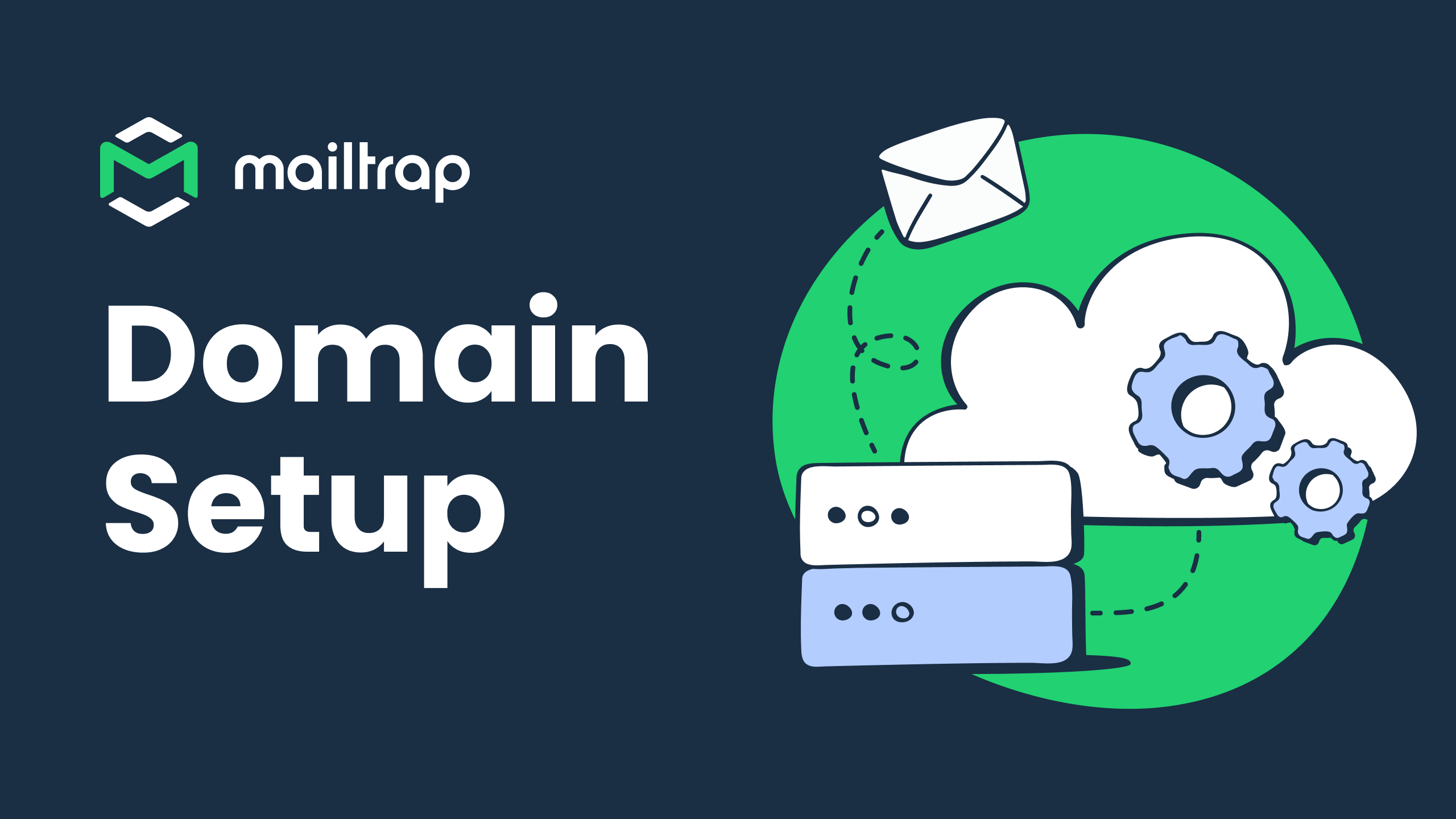Brevo To Mailtrap:
A Migration Guide
This guide covers core principles of how to migrate from Brevo to Mailtrap seamlessly: terminology comparisons, SMTP or API configurations, and other tech specifications needed for a smooth switch.


Key Differences Between Brevo and Mailtrap
- Mailtrap doesn’t require complex setup or deep coding expertise – you can integrate and start sending via SMTP or API in just a few steps. Brevo also supports SMTP and API integration for transactional emails, but requires, in some cases, account-level approval before you can begin sending.
- Depending on the pricing plan, Mailtrap stores full emails in the Email Logs for up to 30 days, with both content and delivery data accessible for 3 to 7 days at no extra cost. Brevo retains delivery statistics for a similar or longer period, but does not store the complete email content for later preview or inspection.
- Mailtrap has separate streams (server endpoints) for bulk and transactional emails. This allows you to send marketing campaigns and transactional messages independently, helping to protect deliverability and keep analytics organized. Brevo supports both transactional and marketing emails, but they run through the same infrastructure unless you manually separate them by sender or IP.
- Mailtrap features Actionable Analytics for both marketing campaigns and transactional emails, offering detailed engagement metrics, bounce and spam complaint tracking, as well as message-level inspection without extra tools. Brevo provides basic transactional stats and robust marketing campaign analytics, but the advanced technical diagnostics, such as full header inspection or spam score analysis, require additional solutions.
- Mailtrap has no rigid rate limits for API sending (up to 500 emails per batch) and allows 10 concurrent SMTP connections per IP by default, with the option to raise this limit based on your use case. Brevo enforces stricter limits on SMTP connections and sending throughput, which can slow down delivery for high-volume workloads.
Mailtrap and Brevo – Similarities
- Support for sending with SMTP or REST API.
- You can use return-path records and DKIM to verify a domain.
- You can add a .csv file to import suppressed email addresses and contact lists.
- Both services allow you to add unsubscribe options to emails without coding.
- You can schedule email campaigns with both platforms.
- Both platforms offer HTML and drag-and-drop builders for creating marketing email templates.
- Both provide analytics for marketing campaign performance (opens, clicks, bounce rates, etc).
- Both services support 2FA.
Terminology comparison
- Users
- Templates
- Blocklist/Unsubscribed Lists
- Tags
- Webhooks
- Custom Headers
- Transactional Parameters
General step-by-step flow for migration
-
After signing up for Mailtrap, select the Sending Domains menu. Add your domain and proceed to verify it. For more details, see our Getting Started Guide.
-
If you choose SMTP service, switch the sending settings as per the credentials Mailtrap provides. See the info under the SMTP header below.
-
Should you select API integration, check libraries and API documentation.
-
Export your contacts list from Brevo as CSV and import it to Mailtrap. Check our step-by-step guide.
Need some help?
Contact our support and our tech experts will help you with it.
-
You can also import your email templates as HTML or create new ones using an HTML or drag-and-drop template builder. For more information, go to the Email Templates guide.
-
If you plan to send more than 200K emails a month, contacting Mailtrap support is highly recommended. They will help you through the process, assign a dedicated IP, and check if everything is set up correctly.
Mailtrap Tip
You can use ActionMailer Balancer Ruby gem to proportionally distribute the email sending load between two different sending services (e.g. 70% Brevo and 30% Mailtrap) to mitigate the sending risks.
Getting started
To start sending emails with Mailtrap, you only need to create an account and verify your domain. Domain setup and verification are done from the Sending Domains menu. Read this article to learn more about that process.
Domain verification
- Once your domain is verified using the provided DNS records, it undergoes an automatic Compliance Check. This process usually takes from a couple of minutes to several hours. You can send emails only after the Compliance Check is fully passed and you see the verified status next to your domain.

- Set unsubscribe options with Mailtrap and import your suppression lists from Brevo. As a reminder, import your email list and HTML templates into Mailtrap.
- Optionally, create webhooks to receive information about bounces, spam complaints, opens, clicks, and other events.
- Enable open and click tracking to understand how customers interact with your emails.
Sending with Mailtrap SMTP
SMTP Endpoints
| live.smtp.mailtrap.io bulk.smtp.mailtrap.io | smtp-relay.brevo.com |
SMTP Ports
| Port | Function | Mailtrap support | Brevo support |
| 587 | The recommended SMTP relay with TLS. | ||
| 25 | High traffic, blocked by some mailbox providers to avoid abuse. | ||
| 2525 | Alternative port, in case you encounter issues with other ports. | ||
| 465 | SSL/TLS encrypted SMTP connection |
SMTP Configuration
Go to Sending Domains and click the verified domain you want to send emails from. Go to the Integration tab and click Integrate under Transactional or Bulk Stream, depending on the type of emails you’d like to send.

Copy and paste the credentials (for the stream you chose) into your app or project, and you’ll be ready to start sending emails. Read more about SMTP integration here.

Note: Turning TLS on is mandatory as mentioned in the credentials.
Sending with Mailtrap API
Mailtrap API tokens
Mailtrap automatically creates a token when you add a domain, and the token has a Domain Admin access permission by default. You can add or remove token permissions in the API Tokens menu under Settings.
For more information on how to manage API tokens, check our guide.
API Mapping
| API type | Mailtrap | Brevo |
| The basics | General | Introduction |
| Email sending | Send email | smtp/email (Transactional) |
| User management | User management | Users API |
| Sandbox | Sandbox API |
API Libraries
At the moment there are nine libraries available at Mailtrap.
| Programming Language | Mailtrap | Brevo |
| Node.js | Node.js SDK | Node.js SDK |
| NodeMailer (Node.js) | NodeMailer SDK | Not supported |
| PHP | PHP SDK | PHP SDK |
| PHP (Laravel + Symphony) | PHP SDK | PHP SDK |
| Ruby | Ruby SDK | Ruby SDK |
| Ruby (ActionMailer) | ActionMailer SDK | Not supported |
| Python | Python SDK | Python SDK |
| Elixir | Elixir SDK | Not supported |
| Java | Java SDK | Java SDK |
API Authentication
We use Bearer authentication. Pass the API token into the code under the header Authorization.
Permissions/User management
If you are on the Business plan or higher, you can add users to your account and manage their permissions. To do it, click the User Management menu under Settings, then the three dots (more menu) on the right. You can also manage users and permissions with API.

Based on the permissions users get, they can view, access, and/or modify specific functionalities of an app. Note that a user needs Admin permissions to get authenticated and send emails via API.
Additionally, Mailtrap allows you to enable or disable app-based 2FA for all or some users within your account, with an option to enforce 2FA for all users. Check our 2FA guide for more details.
If you want to learn more about managing users’ permissions, click this link ◀️.
ActionMailer Balancer for smooth migration
For Ruby on Rails applications, Mailtrap offers an ActionMailer Balancer that makes the migration smooth.
ActionMailer extension allows for the proportional distribution of the email-sending load between two different sending services and mitigates sending risks.
After you install the Balancer in your application and make some minor configurations, it will extend ActionMailer’s sending method.
For more detailed info on the boilerplate and use in development, read the Mailtrap ActionMailer Balancer GitHub page.

